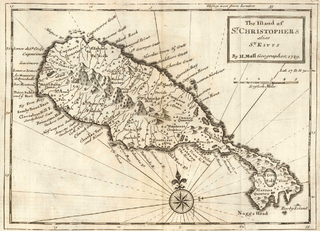
Saint Kitts and Nevis have one of the longest written histories in the Caribbean, both islands being among Spain's and England's first colonies in the archipelago. Despite being only two miles apart and quite diminutive in size, Saint Kitts and Nevis were widely recognized as being separate entities with distinct identities until they were forcibly united in the late 19th century.

The Second Anglo-Dutch War, or Second Dutch War, began on 4 March 1665, and concluded with the signing of the Treaty of Breda on 31 July 1667. One in a series of naval conflicts between England and the Dutch Republic, its causes were a combination of political differences and commercial disputes.
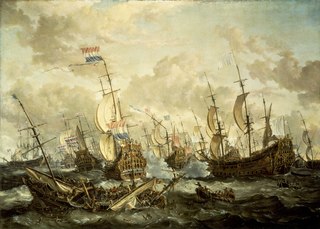
The Four Days' Battle was a naval engagement fought from 11 to 14 June 1666 during the Second Anglo-Dutch War. It began off the Flemish coast and ended near the English coast, and remains one of the longest naval battles in history.
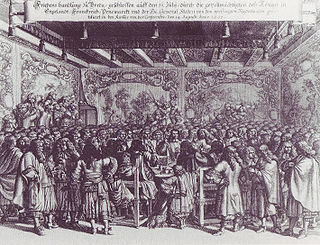
The Peace of Breda, or Treaty of Breda was signed in the Dutch city of Breda, on 31 July 1667. It consisted of three separate treaties between England and each of its opponents in the Second Anglo-Dutch War: the Dutch Republic, France, and Denmark–Norway. It also included a separate Anglo-Dutch commercial agreement.
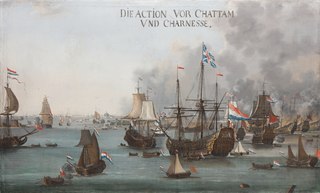
The Raid on the Medway, during the Second Anglo-Dutch War in June 1667, was a successful attack conducted by the Dutch navy on English warships laid up in the fleet anchorages off Chatham Dockyard and Gillingham in the county of Kent. At the time, the fortress of Upnor Castle and a barrier chain called the "Gillingham Line" were supposed to protect the English ships.

Joseph-Antoine le Fèbvre, sieur de La Barre was a French lawyer and administrator best known for his disastrous three years as governor of the colony of New France (Quebec).

Rear admiral Sir John Berry was an English officer of the Royal Navy.

Sir Robert Holmes was an English Admiral of the Restoration Navy. He participated in the second and third Anglo-Dutch Wars, both of which he is, by some, credited with having started. He was made Governor of the Isle of Wight, where he is buried in Yarmouth Parish Church.
Sir Thomas Warner was a captain in the guards of James I of England who became an explorer in the Caribbean. In 1620 he served at the brief-lived English settlement of Oyapoc in present-day Guyana of South America, which was abandoned the same year. The Dutch controlled most of the territory. Warner is noted for settling on Saint Kitts and establishing it in 1624 as the first English colony in the Caribbean.

Abraham Crijnssen was a Dutch naval commander, notable for capturing the English colony in Suriname in 1667 during the Second Anglo-Dutch War, resulting in the establishment of a long-term colony under Dutch control. The minesweeper HNLMS Abraham Crijnssen and the frigate HNLMS Abraham Crijnssen have been named after him.
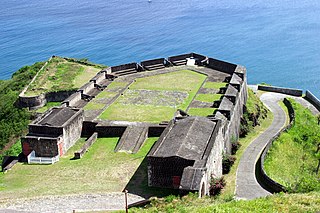
The French invasion of Saint Kitts also known as the siege of Brimstone Hill, from 19 January–13 February 1782, was a part of the American Revolutionary War. After landing on Saint Kitts, the French troops of the Marquis de Bouillé stormed and besieged the fortress of Brimstone Hill. After a month of battle, the heavily outnumbered and cut-off British garrison surrendered. The Comte de Grasse, who delivered de Bouillé's troops and supported the siege, was outmanoeuvred and deprived of his anchorage by Admiral Samuel Hood. Even though Hood's force was inferior by one-third, de Grasse was beaten off when he attempted to dislodge Hood. Hood's attempts to relieve the ongoing siege were unsuccessful, and the garrison capitulated after one month. About a year later, the Treaty of Paris restored Saint Kitts and adjacent Nevis to British rule.
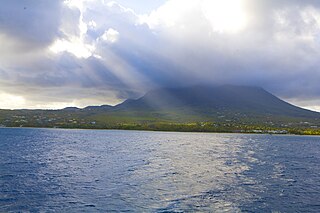
The Battle of Nevis on 20 May 1667 was a confused naval clash in the Caribbean off the island of Nevis during the closing stages of the Second Anglo-Dutch War. It was fought between an English squadron and an Allied Franco-Dutch fleet intent on invading the island. The battle ended up being an English victory in that it prevented a Franco-Dutch invasion of Nevis.
The Capture of Cayenne was a minor military event on the 22 September 1667 during the final stages of the Second Anglo-Dutch War. The French settlement of Cayenne under the French Governor Lefebvre de Lézy was captured in an assault by English sailors and troops of Rear Admiral Sir John Harman's squadron. The English then occupied the settlement stripping it of anything of value before departing two weeks later.

The Recapture of Fort Zeelandia or the Seizure of Fort Zeelandia was a minor military action on 13 October 1667 at the end of the Second Anglo-Dutch War in which an English force under command of Rear Admiral Sir John Harman assaulted and took by force the Dutch settlement and fortress of Zeelandia under Maurits de Rame. The English occupied the area but only for a short while as news of the peace of Breda arrived. The Dutch had captured the Zeelandia earlier in the year, and the English recapture was the last battle before the war's end between England and the Dutch Republic.
Robert le Frichot des Friches, sieur de Clodoré was a French governor of Martinique from 1665 to 1667. He was an energetic and effective leader during the Second Anglo-Dutch War, in which France was an ally of the Dutch from the start of 1666. He used Caribs as auxiliaries, and helped take several islands in the Antilles from the English.

Admiral Sir John Harman was an English officer of the Royal Navy, who served first under the Commonwealth, then Charles II following the 1660 Stuart Restoration.
Charles de Courbon, comte de Blénac was a French colonial administration who served as governor general of the French Antilles during the 17th century. He was an experienced soldier and fought for the king during the Fronde before becoming a naval officer in the French Navy. Towards the end of the Franco-Dutch War he led the land forces that captured Tobago from the Dutch before taking command of the French Antilles. During the Nine Years' War he was active in the struggle with the English and Dutch in the Windward Islands. He captured Sint Eustatius and Saint Kitts, and defended Martinique against a large English expedition in 1693.
Claude de Roux, chevalier de Saint-Laurent was a French soldier, a chevalier of the Knights Hospitaller, who was governor of the colony of Saint Christophe on Saint Christopher Island from 1666 to 1689. He took office in the Second Anglo-Dutch War (1665–67), when the French expelled the English from the island, and left office early in the Nine Years' War (1688–97), when the English expelled the French from the island.

The Battle of The James River took place in June 1667 during the Second Anglo-Dutch War. A Dutch force of five ships led by Abraham Crijnssen sailed through the James River in Virginia searching for English ships. They eventually found them - where they burned and captured them.
The Invasion of Surinam was a Dutch attempt to capture the English held colony of Surinam in February 1667. The Dutch under the command of Abraham Crijnssen captured the colony without much resistance.
















